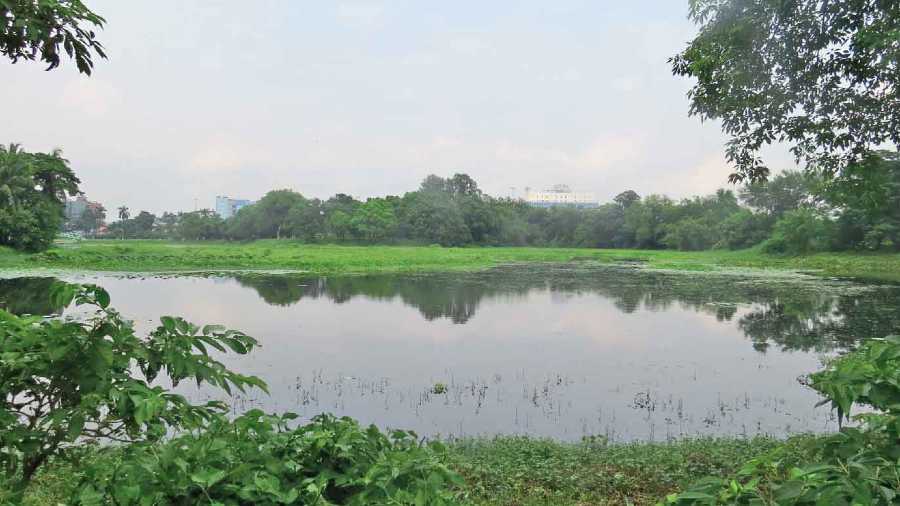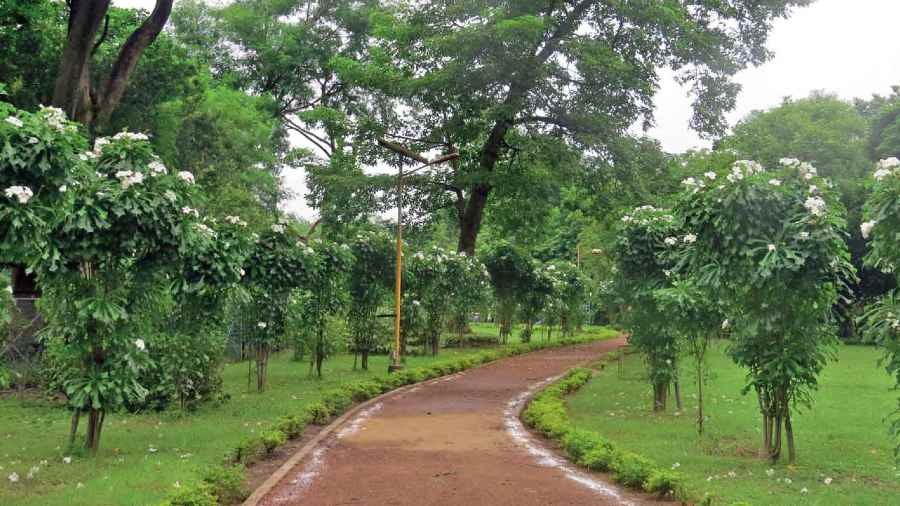Central Park, considered to be the lungs of Salt Lake, is getting a makeover and will soon welcome visitors in its new avatar.
A favourite among morning walkers in the township, the park also attracts people from across the city and its outskirts.
“An allotment of Rs 4 crore has been made for it. We want to rejuvenate Banabitan. We shall plant fruit-bearing and flowering trees and transform it into a beautiful park where residents can relax,” said forest minister Jyotipriya Mallick, who is a resident of BC Block.
The Telegraph Salt Lake provides details of the revamp and the new installations coming up at the park.
New walking tracks
All walking tracks that crisscross the park are being relaid using interlocking paver tiles in bright colours.
The entire revamp of the park is being carried jointly by the state forest department and the West Bengal Forest Development Corporation Ltd (WBFDCL) that already manages several eco-tourism spots and forest bungalows across Bengal.
According to a WBFDCL official, they are repairing all the tracks and the existing tracks will be dismantled before fresh blocks are installed.
“We are using blocks that are not slippery and will not pose a problem for the walkers even during the rainy season. We are also making sure that unlike some of the existing tracks that are quite narrow the new ones are much wider,” said the official.
Cleaned-up waterbody
The waterbody at the centre of the park is being cleaned up.
According to a forest department official, they have been careful not to remove the water hyacinth patches completely as a lot of birds use them for roosting as well as nesting purposes.
A few months back, dead fish had surfaced on the waterbody, prompting the authorities to sit up and take note. “Excessive growth of water hyacinth reduces oxygen levels in the water that leads to death of fish. Although water hyacinth should be cleared, it is imperative that some patches of water hyacinth islands are are kept in place to ensure that birds come here,” said Arjan Basu Roy, an avid birdwatcher and founder of the Nature Mates Nature Club that manages the butterfly garden inside Central Park, near gate number 1.
Central Park attracts a lot of birds and several species including the White Throated Kingfisher, Black Winged Kite, Cattle Egret, Black Drongo, Alexandrite Parakeet have be spotted here.
Migratory birds like the Lesser Whistling Duck too have been spotted here.
Boating facilities will also be started and the old paddle boats will be replaced with new ones.
The authorities also want to set up angling platforms all around the waterbody where catch-and-release system will be encouraged, a WBFDCL official said.

A section of the waterbody in Banabitan Sudeshna Banerjee
A decision on angling though has not been taken as the forest minister is in favour of doing away with the practice altogether to avoid allegations of corruption about the volume of the catch that anglers take home.
Demarcated zones
Much like Eco Park in New Town, WBFDCL will set up “experience zones” inside Central Park.
According to an official, they are setting up a mini Jaldapara zone.
“The idea is to give a taste of Jaldapapra and recreate its fauna in this zone. We will also place models of elephants and rhinos in this zone and the landscape will resemble the forests of North Bengal,” said the official.
On similar lines, a Sunderbans zone is being created and life-size models of the Royal Bengal Tiger will be kept on display and the area will resemble the mangroves of Sunderbans.
Apart from these two zones, an area having statues of Bengal’s legends will also come up.
“This will be a photogenic area of the park and people will be able to take pictures to record their memories,” said Mullick, the minister.
Souvenir shop & cafe
A coffee shop has been planned on the waterfront. Several new shops and temporary kiosks will be strewn across the park.
“While most of the outlets will sell snacks, we are also likely to set up a memorabilia stall inside the park,” said the official.
Information boards
Central Park, that has at least 150 varieties of flowering plants and fruit trees, will now be equipped with boards identifying them as well.
“This will not only benefit normal visitors but will also be great for students coming on nature study trips,” the official added.
Butterfly garden
The butterfly garden too will be renovated and boards identifying butterfly and moth species will be set up.
According to senior officials of the WBFDCL, work is on in full swing and the makeover is expected to be completed by early next year.
“The park was closed for visitors during the pandemic and hence we had our work cut out as it was completely overrun with weeds and tall grass. However, we are confident that we will be able to complete the renovation by early next year,” said the official.
Green concerns
A section of birdwatchers and environmentalists, however, are keeping a close watch on the developments.
According to at least two birding enthusiasts, who visit the park regularly, putting in too much plastic and fibre glass in the form of statues or children’s rides might actually be detrimental for the park’s overall ecosystem.
Both of them expressed concerns that not only a large number of birds but even butterflies and small mammals call the park their home and their habitat might get disturbed if too many items that are “not natural” are introduced into the park.
“Animals and birds get used to their surroundings where they feel safe. Putting in plastic and fibre glass statues that require solid bases to be set up means converting small patches of land into cemented bases. While this is a concern, the greater concern we have is that these statues will have wear and tear and both these materials, including chemical paints, leech into the soil. This will be extremely harmful for the park’s ecosystem,” one of the green activists The Telegraph Salt Lake spoke to said on condition of anonymity.
A large section of the Central Park, that originally measured around 150 acres, has already been encroached upon by man-made structures including the Karunamoyee Bus Terminus, a fairground and the Bidhannagar Municipal Corporation’s swimming pool complex. The latest addition is the sprawling East West Metro car shed that has currently reduced the size of Central Park to a little more than 70 acres.
What kind of changes do you want to see in Banabitan? Write to The Telegraph Salt Lake, 6 Prafulla Sarkar Street, Calcutta 700001 or email to saltlake@abp.in
